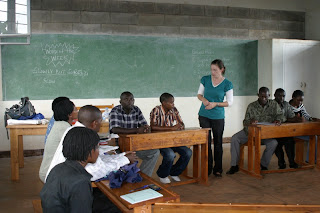It’s only taken 5 months to get to this point but I’m happy I’m finally here. I’m back in the schools and that is really where I belong. I didn’t become a teacher to sit in an office and write reports, that’s for sure! This Monday (after a month long delay in returning back to schools) I began my in service training at five focus schools. In a nutshell, this is how I’ve set up my job – after having taken over from Tina’s work.
There are about 65 schools in Ngoma District. Because I am only one, the system that was set up looks like this: there are workshop groups that are organized geographically. There are five groups in total and each school sends two teachers to each workshop. When I organize a workshop, I facilitate it five times in a row – for each group. The idea is that the two teachers who come, go back to their schools and train others. While this does cover the entire district, it is difficult to follow up and therefore, measure impact. So, we also have five focus schools. These are schools that are spread around the district and are chosen, in part, based on the willingness and commitment of the head teacher. I’ve decided that I will visit each school twice a month, or every other week. I observe teachers and give one on one feed back. Because of the constant visits, I can follow up and give support. In the afternoon, I also give training and will help set up an English Club with the help of a teacher.
Things are going really well, to start. Jeremy is coming with me for the first few weeks to meet some Directors and see some schools in progress. You know, many of the teachers attended a month of English training which, in addition to English training, also gave teachers exposure to group work and pair work and other student centred methods of teaching. In my observations now – compared to October – is that teachers are already all willing to take risks and try new things.
Monday I was at Bare and in the afternoon we started to use rice sacks to create permanent visual aids. In the morning lesson, the little P1 children were learning colours. One little boy at the back row (each row had four or five children) was not listning even a little. Instead, he kept turning to look at me sitting in the back. The teacher taught the class “red colour” and “blue colour”. The children repeated it over and over again (including the little boy). Then, to introduce the colour white, she held up a white sheet of paper. She hadn’t taught this colour yet and so the class was quiet. When she asked “What colour is this?” the little boy – eager to impress me – jumpe out of his seat and yelled “THAT IS BLUE COLOUR!!!” Still looking at me, she told him “no” and he sat down. Oh well. Points for trying. The Director of Bare is always so hospitable. It was so great, we even stayed longer! Okay, no. That was because it was raining too hard to leave right away. But the rain let up for a moment so we hopped on the bikes and….. half way there got caught again. The dirt roads turned to mud and the usually empty gutters turn to red rivers. It reminds me of the chocolate river in Charlie and the Chocolate Facotry. Things weren’t so bad except a pick up truck passed me at the exact time it hit a puddle and my entire left side was covered in mud! It took two days for my shoes to dry out!
Tuesday we went to Kibungo A, so it was nice to be in town. (I managed to buy electricity credit on lunch!) In the afternoon, I worked with two teachers to create some more simple visual aids. Today I was out “in the sticks” at another school. This school is understand by 6 teachers. Classes are huge. One class of P1 children had 63 children. The school they were in is “new” as they were learning under a tree for a few years. This one has benches but only a few of the benches have desks. I observed two lessons in the morning. One was a math class where students were comparing numbers using <, > or =. The children were having difficulty and so was the teacher. If the students got it wrong he would just ask them over and over again” Are you sure?” until they changed their minds! He did use visuals and had the students come up and hold the numbers. The child in the middle held the correct sing. It was a great way to get the learners involved. In the afternoon, we created a Days of Week visual, also, and I challenged them to come up with something for their classes. It’s a competition and the best one, when I come back in two weeks, wins! I also arranged an assembly on the grass for the children. We taught the children to walk in pairs to the meeting spot. And…I even taught P2! Yes folks ME (the junior high teacher) sucked it up and when in. Their teacher was in the training session and so – as they would – were a bit noisy and out of control. So I taught them a little rhyme about opening and closing their hands. I’m definitely not cut out for elementary but it’s a nice change. I guess it’s good to know my strengths.
So yeah…all in all, things are great. I’m totally exhausted but having a ball!
(Thanks to Jason for the idea to melt the rice sacks to seal them and thanks to Jeremy for some of the photos!)

















No comments:
Post a Comment